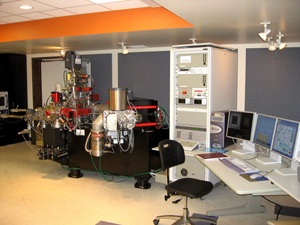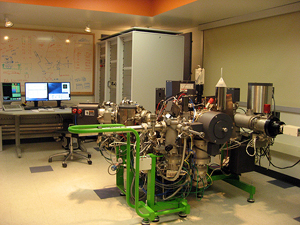The newly established Microanalysis Center for Geochemistry and Cosmochemistry at Caltech houses two Secondary Ion Mass Spectrometry (SIMS) instruments,
also known as ion microprobes. The
Cameca NanoSIMS 50L is a type of ion microprobe designed for elemental
and isotopic analysis of ultra-fine features (with spatial resolutions down to ~50 nm). It also offers extremely high
sensitivity at high mass resolution and the capability of simultaneously measuring up to seven masses from the same
small volume. The
Cameca IMS 7f-GEO is a magnetic sector SIMS instrument based on the Cameca IMS 7f,
but modified for geoscience applications. The combination of these two state-of-the-art ion microprobes in one laboratory provide powerful diverse
capabilities in trace and isotope analysis, depth profiling, ion imaging and geochronology, with low detection limits,
high spatial resolution, and/or high precisions.

Ion Microprobe, CAMECA NanoSIMS 50L

The Microanalysis Center for Geochemistry and Cosmochemistry at Caltech took the delivery of a CAMECA NanoSIMS
50L in last December and finished the installment and on-site tests in this past April. Now the instrument is
fully operational and running well. The CAMECA NanoSIMS 50L is a new ion microprobe, developed for trace element
and isotopic analysis of ultra-fine features. Among the unique new features offered by the NanoSIMS 50L are:
1) The ability to extend the SIMS analysis to extremely small areas or volumes (~35 nm size in cesium, ~150 nm in oxygen)
while maintaining extremely high sensitivity at high mass resolution (HMR). This derives from the revolutionary coaxial
optical design of the ion gun and secondary ion extraction, and from a new design of the magnetic sector mass analyzer.
2) The capability of simultaneously measuring up to 7 masses (ions), ensuring more efficient and precise isotopic ratios
from the same small volume, or better ion image superimposition in imaging mode. Along with the 7 electron multiplier (EM)
detectors, 4 Faraday cups (FC) are also installed on the Caltech NanoSIMS 50L, enabling to achieve the precision and
external reproducibility of isotope ratio measurements down to the low sub-permil level.

Ion Microprobe, CAMECA IMS 7f-GEO

The CAMECA IMS 7f-GEO is a magnetic sector type SIMS instrument based on the
CAMECA IMS 7f with dedicated options for geoscience applications. It is equipped with double secondary Faraday cups for
high precision stable isotope analysis. The primary column on the IMS 7f-GEO consists of a duoplasmatron
source, a microbeam Cs ionization source, a primary beam mass filter, fully automated slits and apertures, ion optics (lenses, stigmators and double deflectors) for primary beam focusing and rastering, and a high accuracy primary Faraday cup combined with a fast beam blanking system for
monitoring the primary beam intensity during measurements. The sample chamber system can accommodate 1” round samples, has a UHV airlock with baking
capability to store additional samples, a liquid nitrogen cold trap, an optical microscope and CCD
camera system. The sample stage (X-Y) is computer controlled with position storage and recall capabilities; it also has a manual
Z-axis for sample height adjustment, which is critical for obtaining reproducible results on different sample mounts.
The normal incidence electron gun for charge compensation can operate from 0-10kV, has a maximum beam intensity ≥80µA. The secondary ion optics are continuously adjustable from -10 to + 10kV, with the imaged
field continuously adjustable from 35 to 250 µm, and a dynamic transfer system which optimizes transmission for analyzed
area up to 500 x 500µm. The Nier-Johnson type double focusing mass spectrometer has fully adjustable position and width on
automated entrance and exit slits, automated contrast and field apertures, a spherical
electrostatic analyzer for energy filtering, an automated continuously adjustable energy slit, a laminated electromagnet
(120 mm radius) for fast peak switching. The detection system consists of an electron multiplier, double Faraday cups, and a micro-channel plate assembly.